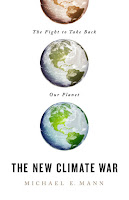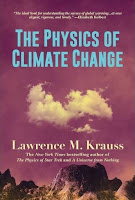Review by Bill Doughty
In the biggest war imaginable, who are the enemies and what is the science needed to do battle? Also, who are the warriors on our side?
“The New Climate War: The Fight to Take Back Our Planet” by Michael E. Mann (PublicAffairs, 2021) is all about people, strategies, and tactics. Mann shows the ways enemies of change –– “inactivists” –– go to battle with the environment and environmentalism. Once a climate skeptic, himself, Mann shows how he learned about the science of the somewhat misnamed “greenhouse effect” and quickly became a warrior for the planet.
“The Physics of Climate Change” by Lawrence M. Krauss (Post Hill Press, 2021) concentrates on science rather than tactics and strategies of warriors. He purposely stays away from left/right politics while presenting evidence of the problem and growing threats: rising concentrations of carbon in the atmosphere, rising temperatures, and rising sea levels (which threaten naval installations worldwide).
Science and facts are the lingua franca –– common language –– to discuss how the war on behalf of the planet can be fought.
Krauss writes, “If it isn’t possible to explain the scientific principles and predictions associated with climate change in a straightforward and accessible fashion, then what hope is there for any rational public discourse and decision-making on the subject?”
To be expected, Krauss’s hard-science and matter-of-fact approach is cold, analytical, and sometimes dense. He presents chemistry and physics equations as long as a thumb. And he includes dozens of charts and graphs to back up his analysis.
Sometimes Krauss comes across as professorial and even condescending. Despite or because of this approach, Krauss will be relatable to engineers and left-brain thinkers.
He becomes most passionate when addressing the ecological threats to the Mekong River, to Greenland, and to West Antarctica, above. Tipping points in the ongoing assault on Earth include warming and acidification of the oceans, dieback of forests in North America (due to fire and disease), loss of permafrost in Siberia and the Arctic, deforestation in the Amazon, and –– of interest to the Navy –– slowdown of the AMOC (Atlantic Meridional Overturning Circulation).
Krauss shows how those tipping points can have a domino effect toward “a future that might be.” He begins his book with observations aboard a boat in Vietnam on the Mekong River and ends with reflections of what it will mean to lose this very special river to the effects of climate change. He writes, “While many factors present in the Mekong Delta make it particularly sensitive to the impact of rising sea level, the Mekong represents, in microcosm, the threat facing much of the world’s population from sea level rise.”
Krauss’s warnings are a call for action. Mann’s book is a perfect companion read.
Unlike Krauss, however, Mann dives into what can and should be done to combat appeasement, fight denialism, and defeat deflection and “doomism” (arguments that it’s already too late to do anything). Mann says we must understand the “fallacy” of “conflating physics and politics.” From "The New Climate War":
“While the laws of physics are immutable, human behavior is not. And dismissiveness based on perceived political or psychological barriers to action can be self-reinforcing and self-defeating. Think of World War II mobilization or the Apollo project. Had we decided a priori that winning the war on landing on the moon was impossible, these seemingly insurmountable challenges would never have been met. We have encountered compelling evidence that a clean energy revolution and climate stabilization are achievable with current technology. All we require are policies to incentivize the needed shift. That doesn’t violate the Newtonian laws of motion, or the laws of thermodynamics. It only challenges us to think boldly. Scratch the surface and we find that most soft doomism is premised not in the physical impossibility of limiting warming, but in a cynical, pessimistic belief that we lack the willpower to act. It’s giving up before we have even tried. And once again, the inactivity are smiling all the way to the bank.”
Mann is responsible for the iconic hockey stick graph published on Earth Day, April 22, 1998, showing the “unprecedented nature of modern global warming.” He says that in a war of this scale it’s important to know your enemy, even if the enemy’s prime tactic is to grind the gears of change through inaction and continue to rely on extraction and burning of a finite resource, damned the consequences. It’s a familiar combination of strategies and tactics by tobacco companies, plastics industry, opioid manufacturers, and COVID deniers, anti-vaxxers, among others. Give ‘em a “D” for dividing us:
“The forces of inaction –– that is, fossil fuel interests and those doing their bidding –– have a single goal –– inaction. We might henceforth call them inactivists. They come in various forms. The most hard-core contingent –– the deniers –– are, as we have seen, in the process of going extinct (though there is still a remnant population of them). They are being replaced by other breeds of deceivers and dissemblers, namely downplayers, deflectors, dividers, delayers, and doomers –– willing participants in a multipronged strategy seeking to deflect blame, divide the public, delay action by promoting ‘alternative’ solutions that don’t actually solve the problem, or insist we simply accept our fate –– it’s too late to do anything about it anyway, so we might as well keep the oil flowing. The climate wars have thus not ended. They have simply evolved into a new climate war.”
 |
| Carl Sagan |
Mann lauds the activist Swedish teen Greta Thunberg and other young people who demand corporate and governmental accountability together with personal responsibility.
Written before the Biden administration came to power and well before Russian hackers disrupted the Colonial pipeline, Mann says presciently, "A renewable energy transition would create millions of new jobs, stabilize energy prices in the absence of fuel costs, reduce power disruption, and increase access to energy by decentralizing power generation."
Krauss, author of “The Physics of Climate Change,” is also cautiously optimistic but only somewhat so; in a seemingly unintended reference to infrastructure, he says the roadbed to oblivion is not an “inexorable” given.
“The future is charging at us like a freight train, but it is doing so on tracks we have built. We may have time to divert the train, or perhaps build a bridge so it safely bypasses us. We will never know unless we try. I wish I had some some silver bullet, but all I can offer is what I have tried to do here, to provide some perspective on the realities we face and how we can understand them.”
Returning to the thoughts of the Mekong, he hopes for rational, reasoned action.
“I hope for the sake of the Cambodians and the Vietnamese, and also for hundreds of millions of Bangladeshis, Indians, Japanese, Chinese, Africans, Polynesians, Indonesians, Middle Easterners, North and South Americans, Europeans, and all the rest, that technological ingenuity combined with rational action, tempered by simple grace and empathy, might supersede our longstanding human traditions of xenophobia, greed, and violence in the face of the national and international challenges we now face.
But hope and expectation are two different things.”
 |
| Louis Pasteur |
“I have had numerous times over the past month to think back to the example of Louis Pasteur, the French biologist and chemist whose groundbreaking work contributed to the principles of vaccination, as well as the technique of pasteurization, named after him. His breakthroughs didn’t end diseases, and they didn’t force government officials to listen to reason. The current nonsensical anti-vaxxers who are rabidly fighting against reality and the social contract, testify to the limitations of rationality among the human species.
Yet Louis Pasteur anticipated that when he said fortune favors the prepared mind. It makes no guarantees. It just offers better odds. I’ll take that any day.”
These two books and the two authors offer a yin-yang, left-brain/right-brain, science/politics (people) approach to the greatest threat facing the world.
In conclusion, a haiku:
we are warriors
to protect our planet if
we choose to enlist
 |
Deputy Assistant Secretary of Defense for Environment and Energy Resilience Richard G. Kidd IV poses for a photo after an interview about climate change, the impact it has on the Department of Defense and what steps the DOD is taking to mitigating it, the Pentagon, Washington, D.C., April 12, 2021. (DoD photo by U.S. Air Force Staff Sgt. Brittany A. Chase)






No comments:
Post a Comment